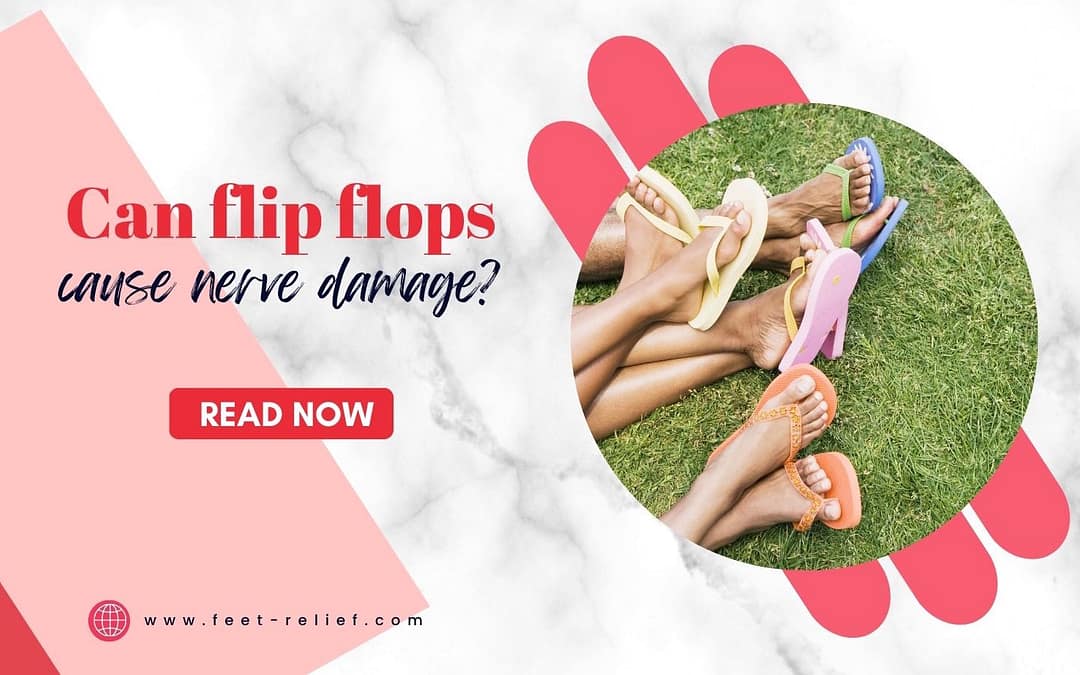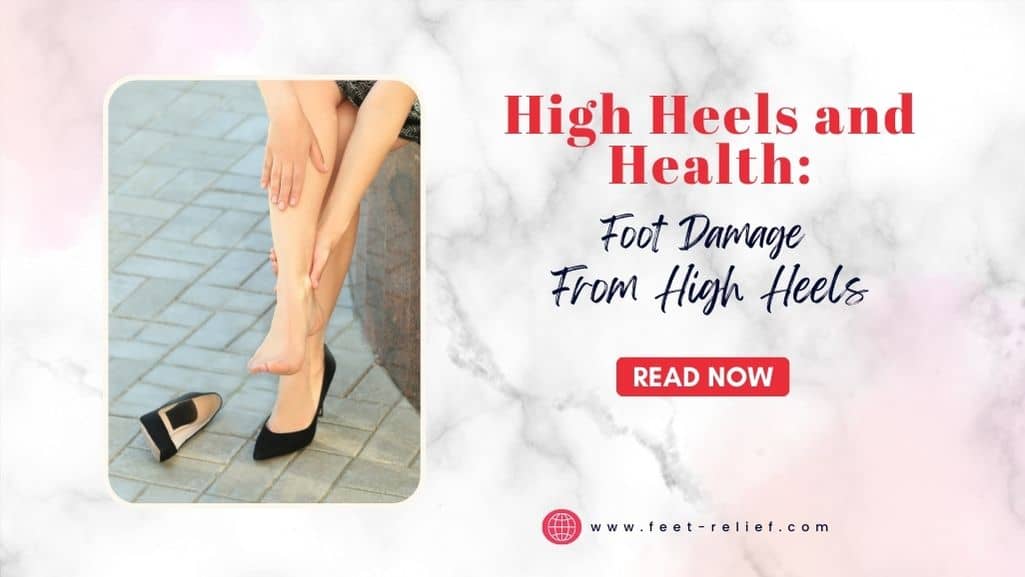
Can Flip Flops Cause Nerve Damage?
Many people love their sandals and flip flops. They slide on easily. Your feet stay cool. What’s not to like? But these shoes do come with some startling warnings. Some statistics show potential health problems. Can flip flops cause nerve damage?
Don’t Flip Out: Understanding the Risks of Wearing Flip Flops and Nerve Damage
Hey there, flip-flop enthusiasts! We all love the casual comfort of these breezy, open-toed sandals, especially during the scorching summer months. But here’s the flip side you might not have considered – the potential risks they pose to your nerve health. Yes, you heard it right: those beloved flip-flops could be causing more than just a fashion faux pas. This quick guide will discover the surprising connection between flip-flops and nerve damage. So, slip into something more comfortable, grab a seat, and let’s unravel this flip-flop mystery.

Flip Flops and Foot Health
Flip flops, the quintessential summer footwear, are often seen as the epitome of comfort. They are easy to wear, airy, and have various designs that cater to any style preference. However, a hidden risk lies behind the apparent convenience and comfort – a potential threat to your foot health. The question that arises is – can flip flops cause nerve damage?
While you might be pondering this, it’s essential to understand that foot health is often overlooked in favor of aesthetics or convenience. However, the feet are your body’s foundation, and any issue with them can affect your overall health and wellness. So, I would like to understand the connection between flip flops and foot health.
This article is not to alarm you but to help you make informed decisions about your footwear choices. By the end of this discussion, you will have gained insights on whether flip-flops can cause nerve damage, common problems associated with flip-flops, the best flip-flop alternatives for feet, and overall foot care tips.
Can Flip Flops Cause Nerve Damage? – Exploring the Connection
The question, “Can flip flops cause nerve damage?” might initially seem outlandish. After all, these are just harmless-looking pieces of footwear. But on closer inspection, the situation is quite different. Flip flops lack arch support, which is essential for your feet. This support helps distribute your body weight evenly across your feet when you walk or run.
Without the necessary arch support, each step waves a shock through your feet, legs, and spine. This can lead to a variety of foot problems, including nerve damage. So, yes, the harsh reality is that flip-flops can cause nerve damage.
Flip-flop neuropathy results from the excessive strain placed on the nerves in your feet due to a lack of support and protection. The nerves in your feet become inflamed and, if not treated, can eventually suffer from irreversible damage.
Understanding Nerve Damage in the Feet
Before delving further into why flip flops are bad for your feet, it’s essential to understand what nerve damage in the feet entails. The feet have a complex network of nerves, which send signals between the brain and the feet. Nerve damage, or peripheral neuropathy, occurs when these nerves are damaged or destroyed, disrupting the normal functioning of your feet.
Symptoms of nerve damage in the feet can range from numbness or tingling to severe pain and loss of coordination. In extreme cases, nerve damage can lead to foot deformities and problems with balance.
Nerve damage is not something that should be taken lightly. It can significantly impact your quality of life, making simple tasks like walking or standing painful or difficult. Early detection and treatment are vital in managing the condition effectively and preventing further damage.

Why Flip Flops are Bad for Your Feet
Now that you understand nerve damage and its implications, it’s time to delve deeper into why flip-flops are bad for your feet. The primary reason is that they lack the necessary support and protection your feet need.
Flip flops usually have a flat sole, which does not conform to the natural arch of your foot. This can lead to foot strain and, over time, can result in conditions like plantar fasciitis, bunions, and hammertoes. But more importantly, the pressure can inflame the nerves in your feet, leading to neuropathy.
Furthermore, flip flops do not offer heel cushioning or shock absorption, meaning every step you take sends a shock wave up your body, potentially leading to shin splints, knee pain, and back problems.
Additionally, the need to grip the flip-flops with your toes to keep them on can lead to various toe problems, including nerve damage. The constant gripping can lead to hammertoes and exacerbate existing bunions. In the long run, it can also lead to nerve damage as the nerves in your feet become inflamed from the excessive strain.
Common Problems with Regular Flip-Flop Use
The problems with flip flops are not limited to nerve damage. Regular use of flip-flops can lead to a host of other foot and leg issues. One such problem is the development of heel spurs, bony growths on the underside of your heel bone.
Heel spurs are often the result of long-term muscle and ligament strain, something that flip flops can easily cause due to their lack of support. The pain from heel spurs can range from a dull ache to a sharp stabbing pain in your heel.
Apart from heel spurs, regular flip-flop use can also lead to other problems, such as stress fractures, especially in the metatarsal bones in your feet. These fractures occur due to excessive pressure on the foot, which flip flops can easily cause due to their lack of cushioning and support.
Lastly, the open design of flip-flops puts your feet at a higher risk of cuts, scrapes, and injuries from sharp objects. It also makes your feet more prone to fungal and bacterial infections.

Case Studies: Flip Flops and Nerve Damage
Several case studies highlight the connection between flip-flops and nerve damage. One such study, published in the Journal of the American Podiatric Medical Association, found that regular flip-flop use led to changes in gait and foot biomechanics, which could lead to long-term foot problems, including nerve damage.
Another study conducted by Auburn University found that wearing flip-flops resulted in shorter strides and a higher risk of tripping and falling. This increases the risk of immediate injuries and the risk of developing chronic foot problems, including nerve damage, in the long run.
These studies clarify that the question is no longer, ‘Can flip flops cause nerve damage?’ but ‘How serious is the risk?’ It’s crucial to understand that even if you’ve been wearing flip-flops for years without any apparent problems, the damage might accumulate silently, waiting to manifest itself in the future.
How to Prevent Nerve Damage from Wearing Flip Flops
Prevention is always better than cure, especially regarding nerve damage. One of the best ways to prevent nerve damage from wearing flip-flops is to limit your use. They should be something other than your go-to footwear for daily use. If you must wear them, try to limit the amount of walking you do.
When choosing flip-flops, choose ones that offer better support and cushioning. They should have a thicker sole and a deep heel cup to absorb shock better. Also, consider flip-flops with a strap around the back of the heel for better stability and less toe gripping.
Finally, ensure that you take care of your feet. This includes regular foot exercises to strengthen muscles, inspections to check for abnormalities, and immediate medical attention if you suspect foot problems.
Best Flip-Flop Alternatives for Healthy Feet
While flip-flops may be convenient and fashionable, there are better footwear choices for your feet. Thankfully, several flip-flop alternatives for feet offer comfort without compromising on foot health.
Sandals with straps offer better support and stability compared to flip-flops. They also reduce the need to grip with your toes, thus decreasing the risk of toe problems and nerve damage.
Another great alternative is closed-toe shoes with good arch support, a deep heel cup, and ample cushioning. These shoes distribute your body weight evenly across your feet, reducing the risk of foot strain and nerve damage.

Foot Care Tips to Avoid Nerve Damage
Taking care of your feet is essential to avoid nerve damage and other foot problems. Here are some foot care tips to help you maintain healthy feet.
Wear the right shoes. As discussed above, choose shoes with good arch support, cushioning, and stability. Avoid wearing flip-flops for prolonged periods.
Exercise your feet. Regular foot exercises can help strengthen your muscles, improve circulation, and reduce the risk of foot problems.
Inspect your feet regularly. Look out for any changes in your feet, such as swelling, redness, blisters, or ulcers. If you notice anything unusual, seek immediate medical attention.
Making the Right Footwear Choices
In conclusion, while flip-flops may seem like the perfect summer footwear, they do not have drawbacks. The question, “Can flip flops cause nerve damage?” has a definite answer – Yes, they can. However, you can avoid nerve damage and maintain healthy feet with the right footwear choices and proper foot care. Remember, your feet are your body’s foundation. Take care of them, and they will take care of you.
Frequently Asked Questions
Can Flip Flops Cause Nerve Damage?
Yes, they can. Flip flops lack proper arch support, and prolonged wear can strain nerves in your feet, potentially causing damage over time.
What steps can I take to prevent nerve damage while wearing flip flops?
Opt for flip flops with arch support, limit long walks in them, and consider alternatives with better cushioning to reduce the risk of nerve strain.
Are there flip flops that are less likely to cause nerve damage?
Yes, look for flip flops designed with orthopedic features and adequate cushioning. These can offer better support and reduce the risk of nerve problems associated with typical flat flip flops.
Unlock the World of Happy Feet at Feet-Relief.com
👣 Are your feet begging for some TLC? Look no further! Dive into the ultimate hub for feet care enthusiasts at Feet-Relief.com. 🌟
👟 Engaging Content: Discover a treasure trove of articles, videos, and guides covering everything from foot health tips to DIY treatments. Our experts spill the beans on how to pamper your feet.
💎 Product Reviews: We’ve put those fancy foot products to the test, so you don’t have to. Find unbiased reviews and recommendations that’ll have your feet feeling fabulous.
🤝 Community Connection: Connect with fellow foot aficionados who share your passion for happy, healthy feet. Swap stories, tips, and advice to keep your feet in tip-top shape.
Your feet deserve the best, and that’s what we deliver at Feet-Relief.com. Step into a world of footcare excellence today! 👣👟 #FeetCare #HealthyLiving #FootLove



















